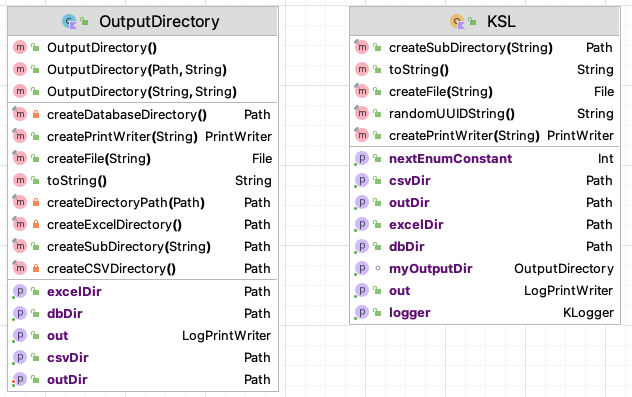D.1 The OutputDirectory Class and KSL Object
We often need to get data into a program or to write data out. Because of the plethora of file formats and differing methods for creating and using files, the KSL provides some utilities for working with comma separated value (CSV), Excel, Markdown, text, and database files. The most relevant classes include OutputDirectory class, the KSL object and the KSLFileUtil class.
Figure D.1 illustrates the functions and properties of the KSL object and the OutputDirectory class.

Figure D.1: OutputDirectory and KSL
The OutputDirectory class is an abstraction for a file directory to store output. When working with a particular simulation model, it is useful to store all of the results and files generated by the model in one directory. The OutputDirectory class facilitates this common use case. An instance of OutputDirectory requires a path to the file directory and then forms some standard sub-directories (excelDir, dbDir, csvDir, outDir) to hold various files that may be generated for these common types of files. The KSL object is, in essence, a default directory to hold all KSL output. Notice that OutputDirectory provides functions for creating files and directories within it. The most useful of the functions is the createPrintWriter(name: String) function which takes in the name of the file and creates a PrintWriter set up to write to the file. Also, notice the createSubDirectory() function. The directories created by this function are relative to the defined output directory. This alleviates the burden of fully specifying path strings and working with paths.
Here is some sample code that uses the OutputDirectory class.
// get the working directory
val path = Paths.get("").toAbsolutePath()
println("Working Directory = $path")
// creates a directory called TestOutputDir in the current working directory
// Creates subdirectories: csvDir, dbDir, excelDir and file out.txt
val outDir = OutputDirectory(path.resolve("TestOutputDir"))
// write to the default file
outDir.out.println("Use out property to write out text to a file.")
// Creates a PrintWriter (and file) to write to within TestOutputDir
val pw = outDir.createPrintWriter("PW_File.txt")
pw.println("Hello, World")
val subDir = outDir.createSubDirectory("SubDir")
println(outDir)The KSL object is essentially a predefined instance of OutputDirectory that creates a default directory called kslOutput within the current working directory. The property out is an instance of a LogPrintWriter, which is a class that wraps a PrintWriter but also has a property called OUTPUT_ON, which has type boolean, where true indicates that output will be written and false turns off the output. You can use this to stop excessive print messages globally. I find this useful for simple debugging messages. Besides this field, KSL has a standard logger for logging program messages.
// use KSL like you use OutputDirectory but with some added functionality
// The PW_File.txt file with be within the kslOutput directory within the working directory
val pw = KSL.createPrintWriter("PW_File.txt")
pw.println("Hello, World!")
// Creates subdirectory SubDir within the kslOutput directory
KSL.createSubDirectory("SubDir")
// use KSL.out to write to kslOutput.txt
KSL.out.println("Information written into kslOutput.txt")
println(KSL)
// KSL also has logger. This logs to logs/ksl.log
KSL.logger.info { "This is an informational log comment!" }